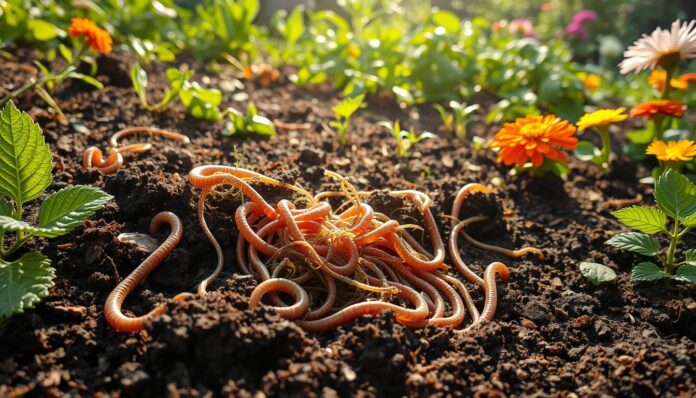Can permaculture soil biology enhancement lead to a more sustainable future for farming? It seems so, as permaculture sites show better soil health. They have 27% more soil carbon and 201% more earthworms than non-permaculture fields. This shows how vital permaculture soil biology is for better soil and farming.
By using permaculture methods, farmers can make their soil better. They can improve its structure, add more organic matter, and keep moisture in. This not only makes the soil healthier but also helps farming be more sustainable. With big environmental problems like soil loss and less biodiversity, permaculture offers a hopeful solution.
Key Takeaways
- Permaculture sites have 27% more soil carbon than non-permaculture fields, showing the value of permaculture soil biology for soil health.
- Soil in permaculture systems is 20% less dense, which helps with moisture and root growth in sustainable farming.
- Earthworms are 201% more common in permaculture sites, showing better soil health and ecosystem services.
- Permaculture can increase soil organic carbon by 71% compared to non-permaculture fields, aiding in sustainable farming and fighting climate change.
- Microorganisms are key in soil for carbon and nitrogen cycling, making permaculture soil biology crucial for sustainable farming.
- Permaculture soil biology can cut down on greenhouse gas emissions from farming, supporting sustainable farming and the environment.
Understanding Soil Biology in Permaculture
Soil biology is key in permaculture, affecting soil health and fertility. Techniques like holistic soil management boost soil biology. This approach helps create a balanced ecosystem that supports microorganisms. These microbes are vital for breaking down organic matter and making nutrients for plants.
Soil organisms are incredibly important. Healthy topsoil has billions of microorganisms that affect decomposition and nutrient availability. These include bacteria and fungi, which rely on root exudates to attract them. Regenerative farming methods, like cover cropping and mulching, help promote soil biology and increase organic soil fertility.
Definition of Soil Biology
Soil biology studies living organisms in the soil, like microorganisms, insects, and invertebrates. These organisms are crucial for decomposing organic matter, fixing nitrogen, and making minerals available to plants. Permaculture and holistic soil management focus on creating a balanced ecosystem that supports these organisms.
Importance of Soil Organisms
Soil organisms are vital for soil health and fertility. They break down organic matter, recycle nutrients, and improve soil structure. By promoting soil biology, farmers can reduce their need for synthetic fertilizers and pesticides. This approach also helps protect the environment and human health.
Interactions in Soil Ecosystems
Soil ecosystems are complex, with many interactions between organisms. For example, nitrogen-fixing bacteria work with legumes, and mycorrhizal fungi help plants absorb nutrients. Understanding these interactions helps farmers use regenerative farming techniques to improve soil biology and ecosystem services. The table below highlights the role of soil organisms in permaculture:
| Soil Organism | Role in Permaculture |
|---|---|
| Bacteria | Decomposition, nitrogen fixation, nutrient cycling |
| Fungi | Decomposition, nutrient cycling, mycorrhizal associations |
| Invertebrates | Soil structure, nutrient cycling, pest control |
By focusing on soil biology and using regenerative farming, farmers can improve soil fertility. This leads to a more sustainable and resilient food system.
Key Components of Healthy Soil
Healthy soils have the right mix of minerals, organic stuff, air, water, and life. This mix is key for keeping moisture and growing crops. In permaculture, microbiology in permaculture is crucial for soil health. Bacteria, fungi, and actinomycetes help break down organic matter and recycle nutrients.
The soil food web is a complex system of relationships. Nutrient cycling in permaculture is vital for making nutrients available to plants. Microorganisms and other soil life play a big role in this process, showing how important microbiology is.
Soil Structure and Composition
Soil’s structure and makeup are key to its health. A balanced structure lets water in, air in, and roots grow well. Adding organic matter, like compost, can make soil better for plants.
Organic Matter and Humus
Organic matter, like compost, is vital for healthy soil. Compost is full of life that helps break down nutrients for plants. Using compost can make soil healthier, leading to better crops and less harm to the environment.
- Compost can improve soil structure and fertility
- Compost can stimulate biological activity and nutrient breakdown
- Compost can support the growth of plants and reduce environmental impact
Soil Moisture Retention
Keeping soil moist is crucial for plants and crops. Soil with organic matter can hold up to 40% more water. Practices like cover cropping and mulching also boost soil health and crop yields.
| Soil Component | Importance |
|---|---|
| Organic Matter | Improves soil structure and fertility |
| Microorganisms | Facilitate nutrient cycling and decomposition |
| Soil Moisture Retention | Critical for plant growth and crop yields |
The Role of Microorganisms
Microorganisms are key to keeping soil healthy. They are vital in permaculture, sustainable farming, and regenerative practices. These tiny helpers break down nutrients, form soil, and help plants grow.
Some microorganisms, like bacteria and fungi, boost plant health and soil quality. For instance, mycorrhizal fungi help plants absorb more nutrients and water. Also, Rhizobium species bacteria fix nitrogen, making it available to plants.
The advantages of microorganisms in soil are many. They can:
- Improve soil structure and fertility
- Enhance plant growth and development
- Increase nutrient cycling and availability
- Support soil biodiversity and ecosystem services
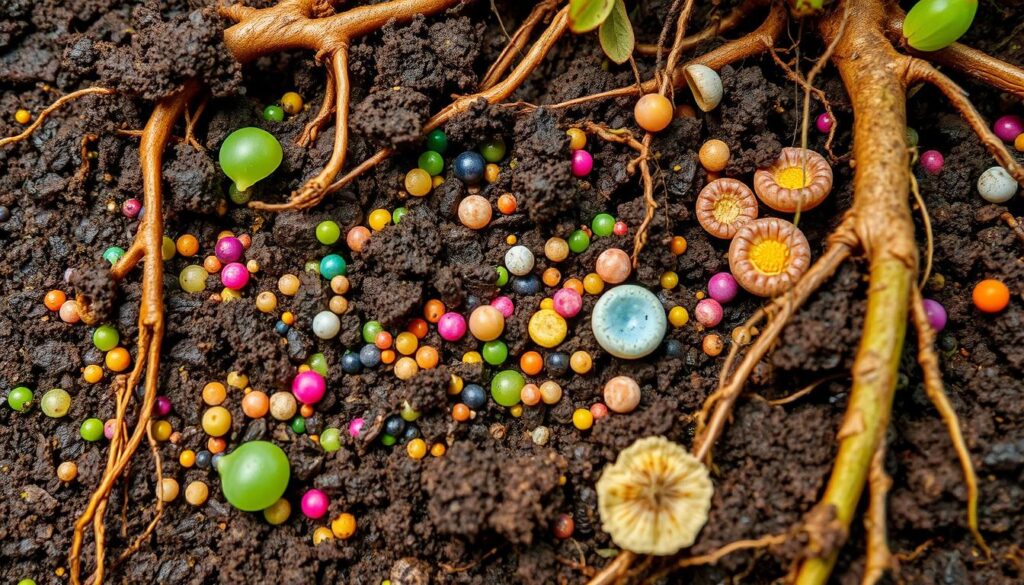
Using permaculture, sustainable, and regenerative farming can boost soil health. This supports beneficial microorganisms. It leads to stronger, more productive ecosystems, better crops, and a greener food system.
Nutrient Cycling in Permaculture
Nutrient cycling is key in permaculture. It helps use resources well and cuts down on waste. Holistic soil management looks at how soil, plants, and microbes work together. Using organic soil fertility practices helps farmers avoid synthetic fertilizers and keep soil healthy.
In permaculture, nutrient cycling breaks down organic matter. This releases nutrients for plants to use. Microbiology in permaculture is crucial, as microbes like bacteria and fungi help decompose matter and make nutrients available.
The Nitrogen Cycle
The nitrogen cycle is vital in permaculture. It changes nitrogen into forms plants can use. Adding organic soil amendments like compost and manure helps this process.
Phosphorus and Potassium Dynamics
Phosphorus and potassium are key for plant growth. Their use is tied to the nitrogen cycle. Knowing this helps farmers use organic soil fertility better and waste less.
Benefits of nutrient cycling in permaculture include:
- Soil health and fertility improve
- Crops grow better and taste better
- Less need for synthetic fertilizers
- Better microbiology in permaculture and ecosystem services
| Nutrient | Importance in Permaculture |
|---|---|
| Nitrogen | Essential for plant growth and development |
| Phosphorus | Critical for root development and plant maturity |
| Potassium | Important for overall plant health and resistance to disease |
By using holistic soil management and understanding nutrient cycling, farmers can build sustainable permaculture systems.
Promoting Soil Biodiversity
Soil biodiversity is key for keeping ecosystems healthy. Soil food web ecology is important for this. Permaculture gardening techniques like cover crops and crop rotation help a lot.
Sustainable agriculture practices also help. Using organic amendments, mulching, and less tillage are good. These methods reduce erosion, improve soil, and boost nutrients.
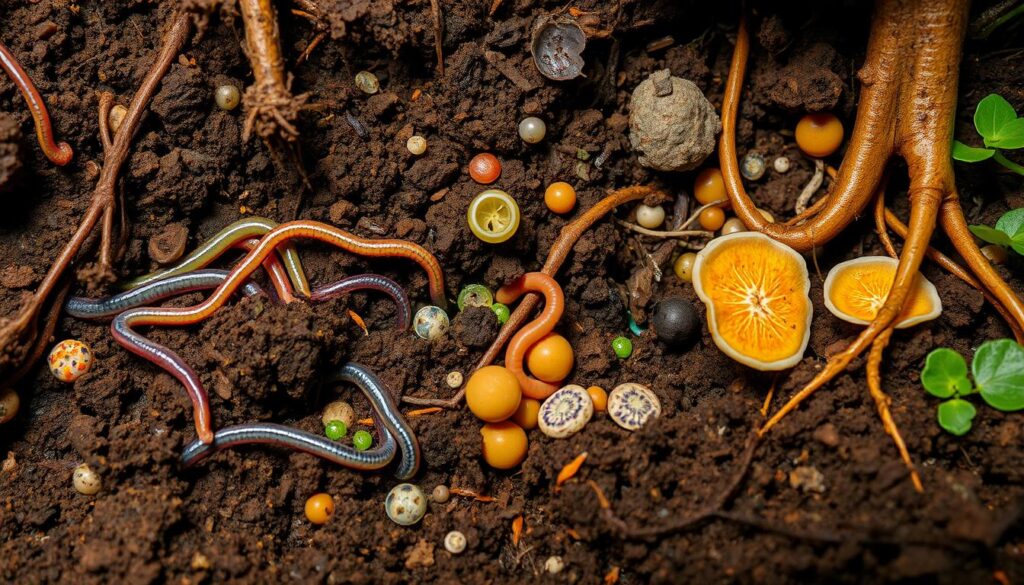
- Improved nutrient cycling
- Increased soil organic matter
- Enhanced ecosystem services
- Increased crop yields
By focusing on soil biodiversity, farmers help make agriculture more sustainable. This is crucial for keeping ecosystems healthy and ensuring we have enough food.
| Practice | Benefit |
|---|---|
| Permaculture gardening techniques | Improved soil biodiversity |
| Sustainable agriculture practices | Reduced soil erosion |
| Soil food web ecology | Enhanced ecosystem services |
Techniques to Improve Soil Health
Improving soil health is key for sustainable farming and gardening. Techniques like cover cropping and mulching boost soil fertility and structure. These methods help farmers and gardeners use less synthetic fertilizers and more organic soil.
Cover cropping involves planting crops between cycles to fight erosion and add organic matter. Mulching keeps soil moist and stops weeds. Composting adds organic matter and supports good microorganisms.
These methods can be mixed for a full soil management plan. For example, cover cropping and mulching together fight erosion and boost fertility. Composting adds organic matter, improving soil structure and fertility.
These techniques offer many benefits. They improve soil structure, increase organic matter, and boost biodiversity. By using these methods, farmers and gardeners can make their soil more fertile and reduce environmental harm. Some main benefits include:
- Improved soil structure and fertility
- Increased organic matter and biodiversity
- Reduced soil erosion and water pollution
- Improved crop yields and quality
By using these techniques, people can help make our food system more sustainable. They also support environmental care.
Managing Soil pH Levels
Soil pH is key to keeping soil healthy and fertile. It affects microbiology in permaculture. The pH scale is from 0 to 14, with 7.0 being neutral. Soils with a pH below 7.0 are acidic, and those above 7.0 are alkaline.
The best pH for most plants is between 6.0 and 6.8. Nutrient cycling in permaculture is also influenced by soil pH. Acidic soils can make phosphorus, nitrogen, and potassium harder to get. Alkaline soils can make micronutrients less available.
Soil food web ecology is vital for soil health. Understanding how pH affects microorganisms and nutrient availability is crucial.

To manage soil pH, regular testing is essential. Here are some tips for testing and adjusting soil pH:
- Test the soil pH using a soil testing kit or by sending a sample to a laboratory.
- Adjust the soil pH naturally by adding organic matter such as compost or manure.
- Use limestone or dolomitic limestone to raise the soil pH, or sulfur or aluminum sulfate to lower it.
| pH Level | Classification |
|---|---|
| 0-3.5 | Ultra acidic |
| 3.5-4.4 | Extremely acidic |
| 4.5-5.0 | Very strongly acidic |
| 5.1-5.5 | Strongly acidic |
| 5.6-6.0 | Moderately acidic |
| 6.1-6.5 | Slightly acidic |
| 6.6-7.3 | Neutral |
| 7.4-7.8 | Slightly alkaline |
| 7.9-8.4 | Moderately alkaline |
| 8.5-9.0 | Strongly alkaline |
| 9.0-14 | Very strongly alkaline |
Water Management in Permaculture
Effective water management is key in permaculture. It affects the health and productivity of the ecosystem. Techniques like efficient irrigation and soil moisture monitoring help keep the soil healthy. They also support sustainable agriculture.
Regenerative farming methods, like using swales and rainwater harvesting, boost water availability. They also help reduce erosion.
Some important irrigation techniques include:
- Drip irrigation to minimize water loss
- Mulching to retain soil moisture
- Using cover crops to reduce soil evaporation
Monitoring soil moisture is crucial. It ensures plants get the right amount of water. This can be done through regular soil tests and moisture sensors. By using these methods, farmers can increase crop yields and save water.
These strategies help make the food system more sustainable and resilient. They also protect the environment and conserve water.
| Technique | Benefits |
|---|---|
| Swales | Increase water availability, reduce erosion |
| Rainwater harvesting | Reduce reliance on municipal water supplies |
| Mulching | Retain soil moisture, reduce evaporation |
The Impact of Soil Compaction
Soil compaction is a big problem in permaculture. It harms the soil’s health and fertility. It’s caused by heavy machinery, foot traffic, and poor management. Holistic soil management is key to stop soil compaction and keep the soil fertile. This method involves understanding soil, plants, and microorganisms. It uses cover cropping and mulching to keep the soil healthy.
The role of microbiology in permaculture is very important. Microorganisms like earthworms and fungi help break down organic matter. They improve soil structure and increase fertility. By supporting a diverse microbial community, permaculture can create strong, healthy soils.
Some good ways to deal with compacted soil include:
- Using cover crops to improve soil structure and increase organic matter
- Applying organic amendments such as compost or manure to promote microbial activity
- Implementing conservation tillage or no-till farming to reduce soil disturbance
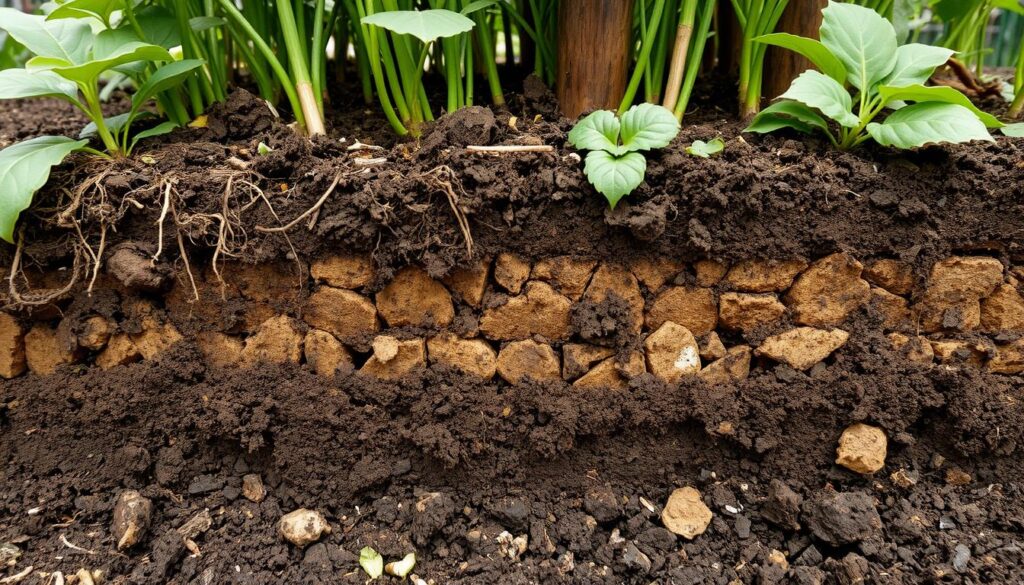
By using these methods, permaculture can fight soil compaction. It promotes holistic soil management. This leads to healthy, fertile soils that support biodiversity and ecosystem services.
| Soil Type | Compaction Solution |
|---|---|
| Clay soil | Use organic amendments to improve soil structure |
| Sandy soil | Use cover crops to increase organic matter |
Utilizing Earth’s Natural Resources
Soil food web ecology is key to keeping soil healthy. Permaculture gardening techniques help a lot. By using earth’s natural resources, like rainwater, we can cut down on harmful chemicals. This makes farming more sustainable.
Harvesting rainwater has many benefits. It helps prevent soil erosion and boosts water in the soil. This leads to healthier soil and better crops. Plus, using natural stuff like compost and manure gives plants what they need, cutting down on chemical use.
Here are some natural amendments and their benefits:
- Compost: rich in nutrients, improves soil structure
- Manure: high in nitrogen, phosphorus, and potassium
- Green sand: natural source of potassium
By using these green methods, we can make our ecosystems better. Soil food web ecology and permaculture gardening help keep soil healthy. This way, we fight climate change, cut pollution, and support more life.
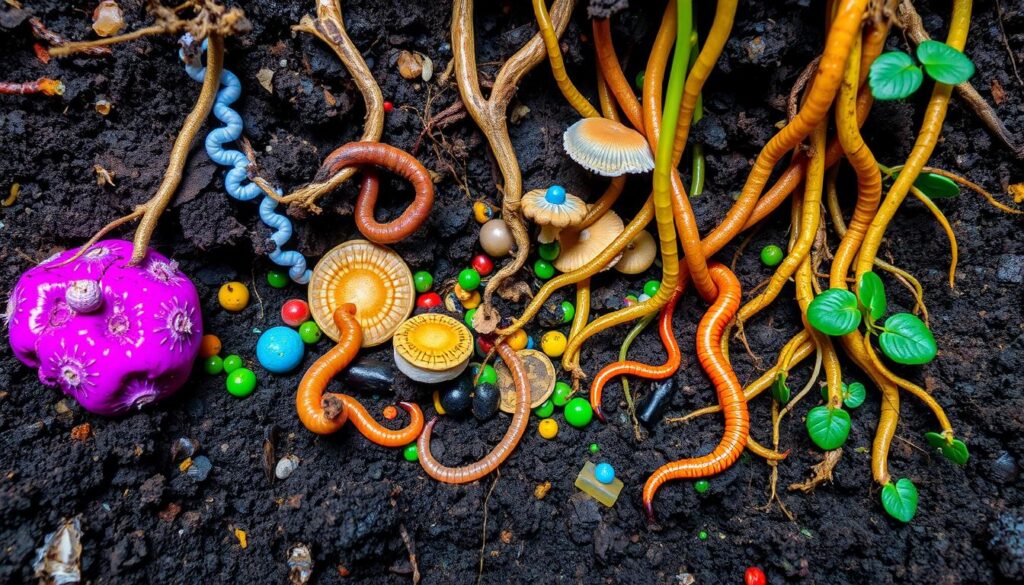
Permaculture Design Principles and Soil
Permaculture design principles are key to keeping soil healthy. By using holistic soil management, farmers boost organic soil fertility. This method aims to design with soil health in mind, looking at soil type, structure, and biodiversity.
Zoning is a major principle in permaculture. It divides land into areas based on use and intensity. This method cuts down on soil erosion, boosts soil organic matter, and saves water. Techniques like cover cropping and mulching help improve soil health and cut down on the need for outside help.
The table below shows how permaculture design principles help soil health:
| Design Principle | Soil Health Benefit |
|---|---|
| Zoning | Reduced soil erosion, increased soil organic matter |
| Holistic soil management | Promoted organic soil fertility, improved soil structure |
| Regenerative farming techniques | Improved soil health, reduced need for external inputs |
By using permaculture design principles and regenerative farming techniques, farmers can build a sustainable ecosystem. This ecosystem supports organic soil fertility and biodiversity. It’s good for the environment and helps make our food system healthier and more sustainable.
Case Studies in Soil Biology
Successful permaculture projects show how key microbiology in permaculture and nutrient cycling in permaculture are. By grasping the soil food web ecology, farmers can build sustainable, thriving ecosystems.
Successful Permaculture Projects
One example is using compost tea to boost soil organic matter. This method has been proven to enhance soil health and raise crop yields. Other successes include using nutrient cycling in permaculture methods like crop rotation and cover cropping.
Lessons Learned from Practices
These projects teach us the value of the soil food web ecology in permaculture design. By knowing the links between microorganisms, plants, and animals, farmers can make their ecosystems more resilient and productive. Important lessons include the need for diverse soil organisms, efficient nutrient cycling in permaculture, and careful soil moisture and temperature management.
By following these principles, permaculture experts can build ecosystems that support soil health, biodiversity, and ecosystem services. As microbiology in permaculture grows, sharing knowledge and best practices is crucial for sustainable and regenerative agriculture.
Challenges and Solutions in Permaculture Soil Biology
Permaculture gardening, sustainable farming, and regenerative techniques are key for healthy soil. Yet, issues like nutrient gaps and soil compaction can pop up. To tackle these, permaculture folks use cover crops, mulch, and compost.
Permaculture boosts soil quality, biodiversity, and ecosystem services. Sustainable farming cuts down environmental harm and boosts soil strength. Techniques like no-till farming help keep soil biota thriving.
Some common soil issues in permaculture include:
- Nutrient deficiencies
- Soil compaction
- Erosion
To beat these problems, permaculture experts employ various methods, like:
- Cover cropping
- Mulching
- Composting
- Integrated pest management
By using permaculture, sustainable, and regenerative methods, farmers can improve soil health. They also lessen environmental harm and support a greener food system.
| Soil Issue | Permaculture Solution |
|---|---|
| Nutrient deficiencies | Cover cropping, composting |
| Soil compaction | No-till or reduced-till farming, mulching |
| Erosion | Contour planting, terracing |
Conclusion: The Future of Soil Biology in Permaculture
Soil biology is key to permaculture’s success. It’s about managing soil holistically and using organic methods. This approach helps create ecosystems that are as healthy as nature’s.
Studies show that microbes can make up to 50% of soil organic matter. They also help make root biomass and exudates stable in soil. This shows how important soil life is for soil health.
Looking ahead, we must focus on keeping soil biology strong. We need to use sustainable practices and avoid chemicals. This way, we can make soil a living part of our world, supporting life and health.

